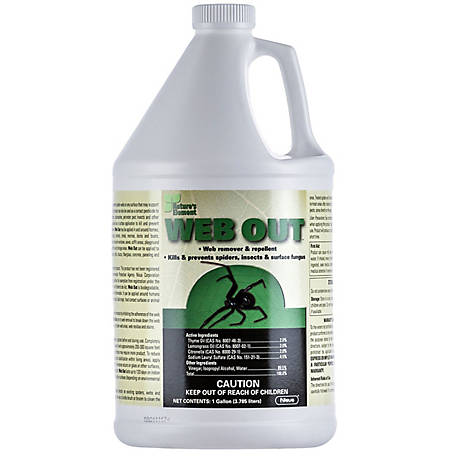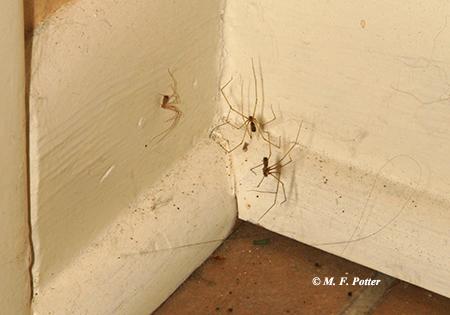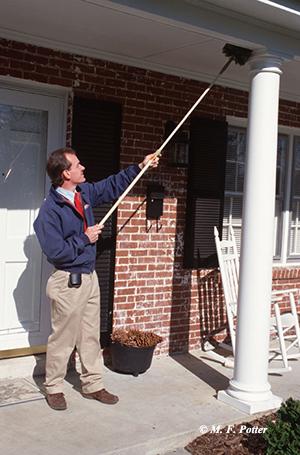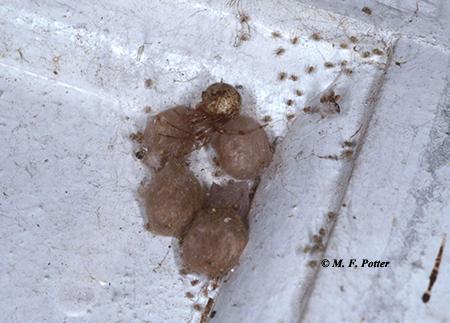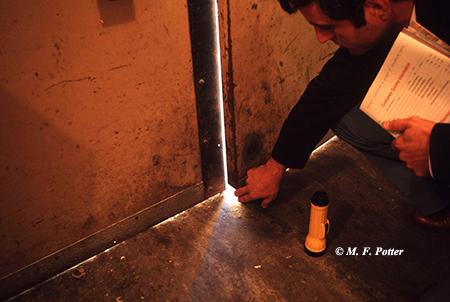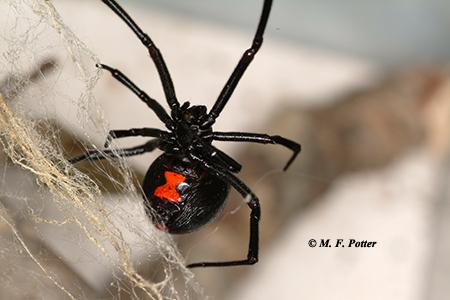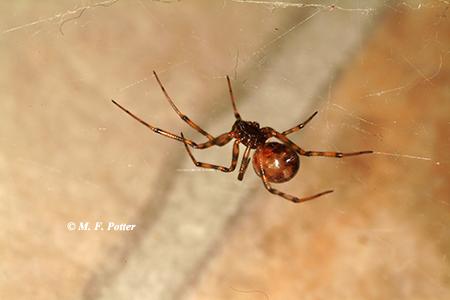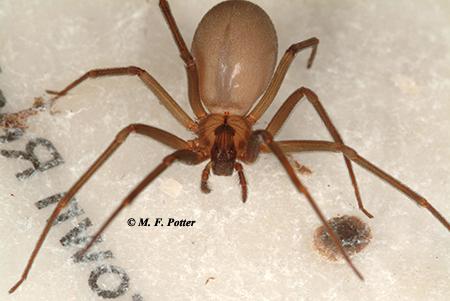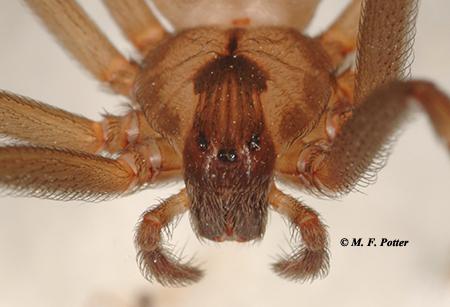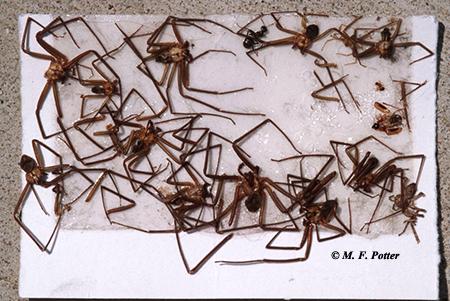Insecticide For Spiders
Many different kinds of spiders live in and around dwellings. Some, such as the cellar spider, construct webs to help entrap their prey. Others, like the wolf spider, are free roaming and make no webs. Most spiders are harmless and in fact beneficial because they prey upon flies and other pests. The majority of spiders have fangs too small or weak to puncture human skin. Those that are capable of biting humans generally will not do so, unless they themselves are harmed or threatened.

Fig. 1: The cellar spider (above) and wolf spider (below) are common in buildings. Both are harmless.
Of the many types of spiders occurring in Kentucky, only the black widow and brown recluse are potentially dangerous. Nonetheless, many people are unwilling to share their home with spiders— harmful or not. Their webs, fecal spotting, and discarded prey can also become an unsightly nuisance.
The following tips pertain to managing all spiders, followed by information specific to the black widow and brown recluse:
- Routine, thorough house cleaning is the best way to eliminate spiders and discourage their return. A vacuum cleaner or broom effectively removes spiders, webs, and egg sacs. Destruction of egg sacs is crucial since each can contain hundreds of young spiders.

Fig. 2: A broom or vacuum effectively removes spiders, webs, and egg sacs (above).
Destroying egg sacs can prevent emergence of large numbers of young spiders (as shown here; below).
- Spiders prefer quiet, undisturbed areas such as closets, garages, basements, and attics. Reducing clutter in these areas makes them less attractive to spiders.
- Large numbers of spiders often congregate around building exteriors. Moving firewood, stacked items, and debris away from the foundation helps reduce migration indoors. Shrubs, vines and tree limbs touching the house should also be trimmed back since these afford harborage and a convenient bridge to the structure.
- Install tight-fitting window screens and door sweeps to exclude spiders and other pests.

Fig. 3: Gaps under doors are a common entry point for spiders.
- Consider installing yellow or sodium vapor light bulbs at outside entrances. These lights are less attractive than conventional bulbs to night-flying insects, which in turn, attract spiders.
- To reduce spider entry from outdoors, insecticides can be applied as a ‘barrier spray’ around the perimeter of the building. Pay particular attention to door thresholds, garage and crawl space entrances, foundation vents, and the bottommost edge of siding. Products containing ingredients such as bifenthrin, cyfluthrin, deltamethrin or lambda cyhalothrin are effective, but may need to be applied periodically (e.g., monthly or bi-monthly) during warmer times of the year.

Fig. 4: Insecticide sprays can often help deter spiders and other pests from entering homes.
Black Widow Spider- Of the spiders able to inflict a serious bite, the black widow is probably the most well-known. The adult female is about 1/2-inch long, shiny black and usually has a red hourglass pattern on the underside of the abdomen. In some varieties and juvenile spiders, the distinct hourglass marking may be reduced to separate reddish spots on the lower or upper surface of the abdomen.

Fig. 5: The black widow can inflict a serious bite and should be treated with care.
Black widows belong to the ‘cobweb’ family of spiders that spin loosely organized webs. Other varieties of cobweb spiders, including the common house spider, are harmless. In Kentucky, black widows are seldom found indoors. They typically dwell outdoors under rocks, boards, or yard debris (e.g., stacked flowerpots). When black widows are discovered in homes, they are usually spotted in vestibules and garages, or at times, sheds and outbuildings.

Fig. 6: The common house spider is related to the black widow but is harmless.
Like other spiders, the black widow is timid and will only bite in response to being threatened or injured. People are usually bitten when lifting objects or reaching into areas where a spider is hidden. Black widow venom is a nerve toxin and its effects are rapid. The victim suffers painful rigidity of the abdomen and usually a tightness of the chest. Blood pressure and body temperature may rise, and sweating, localized swelling, and nausea may occur. In rare cases, the victim may go into convulsions 12 to 24 hours after being bitten and die if not given medical attention. First aid for black widow spider bites involves cleaning the wound and applying ice packs to slow absorption of venom. Victims should promptly seek medical attention. Most black widow bites respond to pain medication and muscle relaxants. An antivenin is also available for severe cases.
Brown Recluse Spider- Unlike the black widow, the brown recluse is often confused with other non-hazardous brown spiders. It ranges from a dark cream color to dark brown, with the abdomen darker than the rest of the body. It has a violin-shaped marking on the top, fore-section of the body (thus, the namesake ‘fiddle’ or ‘violin’ spider). Brown recluse spiders also have three pairs of eyes (6 total) rather than the usual eight for most other spiders.

Fig. 7: Brown recluse spiders have a fiddle-shaped marking and three pairs of eyes, arranged in a semi-circle.
The brown recluse roams at night in search of prey and mates. During the day, it usually hides in concealed places, where it may spin a mat-like web. It is shy and will normally retreat if threatened or disturbed. Nonetheless, people are sometimes bitten while putting on a shoe or clothing that a spider has chosen for its daytime retreat. Other bites may occur when a sleeping person contacts a spider that has crawled on the bed. The bite of a brown recluse is usually painless until three to eight hours later when it may become red, swollen, and tender. Later, the red area around the bite may develop into an ulcerous sore. Healing often requires a month or longer, and the victim may be left with a deep scar. Prompt medical attention can reduce the extent of ulceration and alleviate other complications that may develop.
Persons bitten by a spider which they think is a brown recluse should try to collect the specimen and bring it to a qualified individual for identification. Positive identification by an expert will help the physician decide on the appropriate course of treatment.
Controlling Recluse and Widow Infestations
Thorough inspection of cracks, corners, and other dark, undisturbed areas with a bright flashlight will help determine the location and extent of infestations. Both brown recluse and black widow spiders construct irregular webs. When inspecting for the brown recluse indoors, pay particular attention to basements, attics, crawl spaces, closets, under/behind beds and furniture, inside shoes, boxes of stored items, and hanging clothing. Recluses also may hide above suspended ceilings, behind baseboards, and around ducts and registers. An effective way to detect hidden infestations is to install glue traps. The sticky cards can be purchased online or at hardware/farm supply stores. Placed flush along the bottom of walls and in corners of rooms, the traps will help reveal ‘hotspots’ and capture wandering spiders.

Fig. 8: Brown recluse spiders caught on a glue trap. Several traps should be placed into corners and flush along walls.
Brown recluse and black widow spiders also live outdoors in barns, sheds and woodpiles, behind window shutters, and beneath lumber, rocks, and yard debris. Removal of clutter is helpful in making areas less attractive to the spiders. To avoid being bitten, wear heavy gloves when inspecting inside boxes or moving potentially infested materials.
Infestations of both species often warrant the use of insecticides. Several sprays are available for controlling spiders, ants, cockroaches, and other crawling insects. Effective ingredients (listed in fine print on the insecticide container) include cyfluthrin, bifenthrin, deltamethrin, and lambda cyhalothrin. Insecticides formulated as dusts are also quite effective, including Cimexa® (silica gel), Tempo® (cyfluthrin), and DeltaDust® (deltamethrin). Apply the dust as a fine deposit barely visible to the naked eye. Spiders and other pests tend to avoid powdery accumulations much as we would avoid walking through a snowdrift. The easiest way to apply such a small amount is with a ‘bellows’ hand duster sold in hardware stores or online.

Fig. 9: Dust insecticides are easy to apply with a bellows duster.
Treat all areas where the pests are living, contacting as many spiders and webs as possible. Pay particular attention to crevices along baseboards and windows, and along sills, joists and rafters in basements, crawl spaces, and attics. Total-release pesticide foggers known as ‘bug bombs’ are seldom effective against these spiders, and should only be considered when treating inaccessible areas such as attics.
Infestations of brown recluse or black widow spiders often require specialized skills and equipment to eradicate. In these cases, it would be prudent to enlist the services of a professional pest control company.
Insecticide For Spiders
Spiders are a nuisance in many homes, and they can be hard to get rid of. The best way to get rid of spiders is by using insecticide. In order to get rid of spiders, you need to know what kind of spider you are dealing with, and then use the correct insecticide for that type of spider. You also need to know where the spiders are coming from so you can treat the problem area effectively.
The type of spider will determine which insecticide is best used to kill them. For example: if you have a cobweb spider problem in your home, then you will want an insecticide that kills cobweb spiders. There are many different types of cobweb spiders, including the common house spider (like the black widow), orb weaver spider (like the brown recluse), sac spider (like the yellow sac), and funnel web spider (like the hobo). Each kind has its own unique characteristics that will determine which insecticide works best on it.
You can also differentiate between male and female spiders by their size and coloration. Male spiders tend to be smaller than females because they do not grow as large as females do during their lifetime due to mating requirements.
List Of Insecticide For Spiders
- Not for sale in: CT, VT
- Power Source Type: Manual
Additional Info :
| Color | Off-White |
| Item Dimensions | |
| Height | 8 Inches |
| Width | 2 Inches |
| Length | 4.25 Inches |
| Weight | 1.25 Pounds |
- Demand cs controls more than 30 Common insects including spiders, ants, flies, wasps, fleas, ticks and bed bugs.
- Demand cs is a water-based insecticide concentrate that offers excellent indoor and outdoor pest control.
- Each 8 oz bottle makes 8 – 40 gallons (mixed at 0. 2 to 0. 8 oz/6 to 24 ml per gallon of water).
- The LOT Number printed on the bottle is not an expiration date
Additional Info :
| Color | Beige |
| Item Dimensions | |
| Height | 5.8 Inches |
| Width | 1.8 Inches |
| Length | 3.5 Inches |
Additional Info :
- Cypermethrin 25.3%
- Viper EC is for use inside as a crack and crevice spray of nonfood areas including cabinets, windows, doors, closets, shelves, baseboards, and garages. Outdoors Viper may be applied to all areas as a broadcast spray. It has a bit of an odor to it so we recommend testing outside before applying inside.
- Mix Viper Insecticide at a rate of 1.3 oz. per gallon of water and apply as a coarse spray to areas of pest infestation. Fill sprayer with the desired volume of water and add Martins Viper EC Insecticide. Close and shake before use in order to ensure proper mixing. Shake or re-agitate sprayer before use if spraying is interrupted. Make up only as required; repeat treatments when needed.
Additional Info :
| Color | Clear |
| Item Dimensions | |
| Height | 7.9 Inches |
| Width | 1.8 Inches |
| Length | 3.9 Inches |
| Weight | 0.08125 Pounds |
- BEST NATURAL SOLUTION TO BEAT MILDEW, MITES AND MOLD – Crop Control is hands down the BEST choice to protect and cure Powdery Mildew, Spider Mites, Russet Mites, Broad Mites, Botrytis, Grey Mold, Aphids, fungal and parasitic species on plants.
- SUPER CONCENTRATED FORMULA SIMPLE AND EASY TO USE – Every 1/2 ounce of Trifecta Crop Control makes one gallon of ready to use spray – Simply mix with water and spray on your plants to prevent and cure up to one week before harvest and stay free of mildew, mites and mold. The simultaneous modes of action create a powerful defense system that stops fungal and parasitic species dead in their tracks
- GOOD FOR USE ON MOST PLANTS – Use for most crops including fruits, vegetables, herbs, spices, roses, flowers, trees, shrubs, houseplants, succulents, ornamentals and more. Save time and money with this quick and easy solution to mildew, mold, and fungus. *Test spray a few leaves full application*
- PROVEN RESULTS AND FARMER RECOMMENDED – Unique blend of food grade HIGHEST-QUALITY essential oils including garlic, thyme, clove and peppermint oils broken down to NANO-SIZE particles for MAXIMUM COVERAGE. Crop Control contains all-natural ingredients and pet-friendly and food grade product so you can feel good about what you are putting on your plants and the planet.
- GUARANTEED TO WORK FOR YOU – We are totally confident that Trifecta Crop Control will work for you, as it has for thousands of other growers. With your Trifecta Crop Control purchase, you are protected by Amazon’s money back guarantee (all terms apply) so you can order now with CONFIDENCE
Additional Info :
